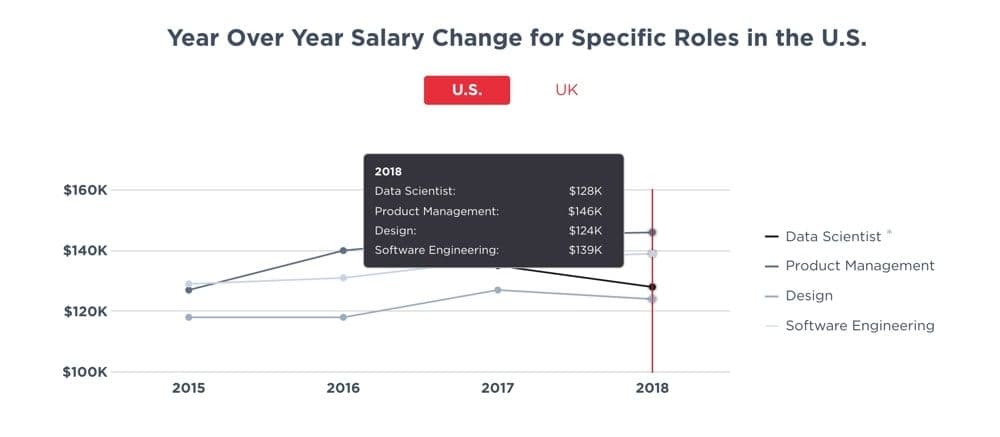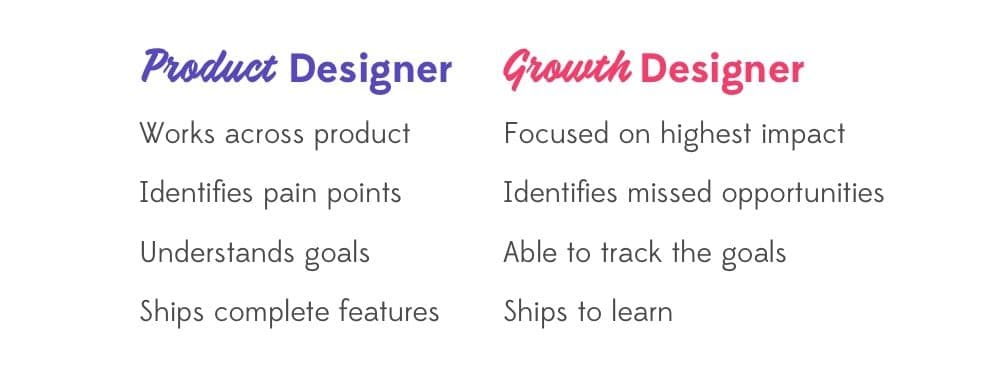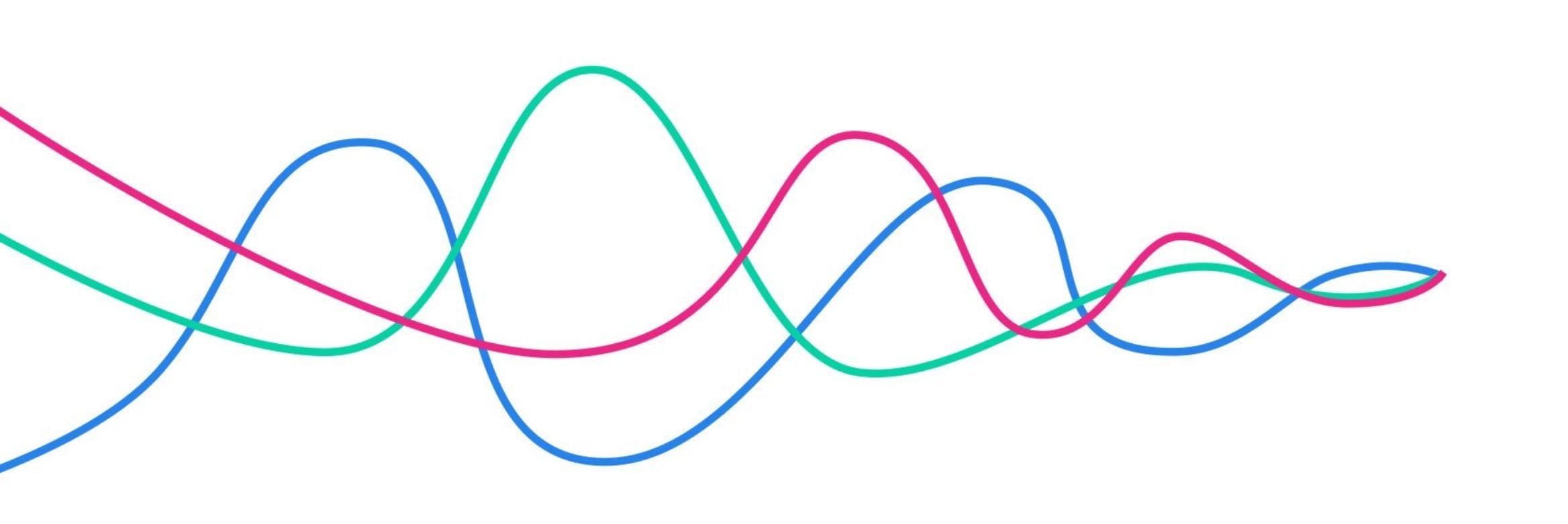Practicing Growth Design
Designers, grow your career with data. Lex Roman shares the essential growth design tools and skills to master.
I identify as a Growth Designer.
A few years back, I wrote about how I see growth design. Here’s how I defined it:
ref Growth designer: A person who approaches product design through the dual lens of customer experience and business impact.
“Growth Designer” is not usually my actual job title, but I find that label useful for people to understand my skillset. It differentiates those of us who embrace data, validation and experimentation. It’s made it easier to find companies who want more from design than just interfaces. Companies that want someone who can help propel their business forward.

More importantly, it helps define a practice of design that is as much about the business as it is about the customer. You may think to yourself: “Isn’t that just design?” and the answer is very much no. Many design practitioners are unable to tie their work to business value. We talk about design as a strategic business driver and yet, we rarely prove it.
This post is for those who want to learn more about these practices so they can be designers who can demonstrate value.
Why Designers Should Care about Growth
Before we get into practices, let’s talk about why you should care about growth.
How often have you heard…
ref “What’s the business value of design?” “What’s the ROI of design?” “Do we even need design?”
The answer to all these questions lies in the demonstration of impact. Not just design that has goals. Design that measures, meets and exceeds goals.
When you join a company, you relying on their understanding of whether or not design is valuable. Designers are still paid less than their engineering, data and product counterparts. Design founders and design executives are rare. Design tends to be greatly outnumbered by engineering on individual product teams. And when the practice of growth hacking became prominent several years ago, design was barely part of the conversation and was certainly not driving it.
Design tends to be greatly outnumbered by engineering on individual product teams.
2019 State of Salaries Report (by Hired). Design is the bottom line.

We don’t have to rely on the perception of the value of design. We can prove its value. (Growth) Designers who can demonstrate value are an emergent breed. Designers who care about business health and growth. Designers who can understand, drive and measure their impact. They exist. More and more of them are proudly owning their skills and sharing their techniques.
How Growth Design Differs from Product Design
Product Designers work across a product or service. They’re generalists with some depth in certain areas. They’re thinking thoroughly about end to end customer experience. They look for opportunities to solve pain. While they are typically driving towards a business goal, I find they’re not directly measuring them.

In contrast, Growth Designers deep dive into their impact day to day, week to week, month to month. They care about that impact just as much as they do customer experience. They understand how to use data. They seek to de-risk their ideas with evidence. Where the Product Designer is looking at that holistic experience, the Growth Designer is laser focused on finding levers for growth.
Growth Designers deep dive into their impact day to day, week to week, month to month.
The Growth Design Toolkit
Since this post is about practicing growth design, I’m focusing on the skills that are underdeveloped in Product Designers that are key for growth. I’m not going to cover much about design itself. The design skillset is still critical in growth design. All the capabilities you expect from a Product Designer are relevant: customer research, designing flows and interactions, visual design, understanding of technology. What’s different is the focus on impact and the skills to be able to drive it.

Focus. Designers who drive impact are able to stay focused on the goal.
Goal Setting
Driving outcomes is hard work. Driving output is a lot easier. Hopefully, you work at a company that sets goals. The main difference between a growth focused team and other teams is the radical focus on one goal. When you’re trying to move signups, retention, revenue, referrals, you have to laser focus on that thing. Now, as a designer, you may not be leading goal setting, but if your team is taking on five goals, you’re not going to hit them. Being able to help your team focus on the high impact stuff is critical to success. Otherwise, you fall down a rabbit hole of features and your impact is diminished or non-existent.
Being able to help your team focus on the high impact stuff is critical to success.
Learn: Goal setting techniques, How growth practitioners set goals
Resources: “Hacking Growth” by Sean Ellis and Morgan Brown, “Set Product-Specific Goals” by Roadmunk
Prioritization
It’s great when you have high impact goals. Perhaps your team decided: “Yes, we’re going to drive up revenue. Let’s crush it!” But then you look at your backlog each week and it’s all random tickets that somehow made their way in there: features, tech debt, bugs, something called “design polish.” And it turns out none of these tickets are actually doing anything to help you drive revenue.
Your list of work needs to be focused on the impact you want to have. As you do planning, as you review the work that your team is picking up, as you think about what your day-to-day work is, ask yourselves: “How is the thing I’m working on going to drive our goal?” How we spend our days is how we spend our lives. What we work on determines what we will impact.
Learn: Prioritization techniques
Resource: Amplitude’s John Cutler on Why PMs Should Measure Themselves on Value Creation Not Output

Investigate: Designers who drive impact have the ability to thoroughly unpack an opportunity.
Quantitative Research
Designers approach data from a different lens than other disciplines. They have the ability to see human behavior in data. For example, in a tool like Amplitude, you can go through and see what people are doing, where they are leaving. This is where designers can really uncover behaviors and understand how their products are being used.
Designers have the ability to see human behavior in data.
Learn how to use an analytics tool. Learn about different ways to look at customer behavior. Ask a teammate to help you answer a question you have about your product.
Learn: Analytics tools, How to view reports that show customer behavior
Resources: Why Designers Need to Care about Data, Analytics for Everyone
Customer Development
Customer development is an undervalued area of skill for all designers. It is a technique originated by Steve Blank that is common in lean startup practice. The idea is that you work with your customers to understand their problems, behaviors and scenarios. You’re building along with them rather than forcing solutions onto them or waiting until you have that solution to validate it.
For growth practitioners, customer development can help you identify opportunities. When you interview people about the problem you’re solving or the situation where they might use your product, you are listening for your opportunity to solve pain or confusion. If all of your customer research revolves around solution and usability testing, you are missing the chance to find unmet needs, to solve new problems and to crack growth levers.
Learn: How to recruit real customers, How to interview customers around a problem space
Resources: “Running Lean” by Ash Maurya, “The Four Steps to the Epiphany” by Steve Blank
Competitive Research
Many designers do competitive research that’s focused around features or interfaces. There’s a real opportunity for designers to be thinking about competitors in terms of value propositions. Asking: Who’s going to come out of left field and take your company down? What are customers saying about your competitors? What do they find valuable? Who in the market is doing something exceptional that your companies should be paying attention to?
Jaime Levy offers a step by step process for this in her book, UX Strategy. She even has a free toolkit online to get you started.
Learn: How to do competitive research through the lens of both customer and business value
Resource: “UX Strategy” by Jaime Levy

Ship. Designers who drive impact ship often and participate actively in the conversation about what to ship.
Validation Methods
Let’s say you come up with a vision for something. You learn that something is completely broken and it needs to be overhauled. Rather than let someone else chop that vision into phases, designers can actively participate in that conversation. Learn how to identify the riskiest part of a design. Learn validation methods like feature fakes, A/B testing, price testing, wizard of oz, landing page tests. There is an infinite number of ways to validate product direction and there are loads of blog posts about what folks have learned.
Learn validation methods like feature fakes, A/B testing, price testing, wizard of oz, landing page tests.
Learn: Different validation methods, What’s worked for other teams who run experiments, Experimentation tools
Resource: Validating Design Decisions
Follow Through
Once you’ve shipped something, reflect on why it worked or didn’t work. How did customer behavior change? What did you learn? What do you need to learn next? Take a moment as a team to think about that. It’s really hard to do this in today’s Slack-email-meeting-document-slideshow mode of operation. But if your team doesn’t make a thoughtful effort to learn from their actions and iterate, you will leave money on the table.
Learn: Reflection techniques, How to run effective meetings
Resource: Principles of Experimentation Flow by David Bland

Measure. Designers who drive impact know how to measure their work.
Instrumentation
Instrumentation is a particularly empowering skill for designers. Instrumentation is the code that your team writes to decide what gets tracked about user behavior. Depending on how big your team is, designers may not have to define instrumentation, but it’s useful to understand this is a step that has to happen. The more you participate in it, the clearer the data becomes. Learn how this process happens at your company. Learn how you can see everything that’s been instrumented. Learn how you can ask for additional instrumentation.
Learn: What instrumentation is, How your team instruments events
Resource: Segment’s Analytics Academy
Behavioral Analytics
The closer you are to the data, the more clear it is how to impact the business. From the design lens, you can help dive beyond a vague measurement like conversion and help your team understand the humans on the other side of it. Learn what tools are available at your company. Learn how to look at user journeys in analytics tools like Amplitude and Mixpanel. Learn how to slice data in different ways. Learn how to measure whether or not your design was successful.
Learn how to slice data in different ways.
Learn: Some of the more exploratory data tools that offer stories behind the charts
Resource: Amplitude’s Pathfinder Tool

If you learn and empower yourself with the tools above, you can own the value of design. Not just for yourself, for design as a field. When we prove the impact of design, design becomes a strategic business driver. Companies that make this connection invest more in design and in designers.
When we prove the impact of design, design becomes a strategic business driver.
Keep in mind that while this post is focused on design, growth is a team sport. You need cross-functional collaboration to make companies successful. Historically, designers have not made their contributions and value clear. Expanding your skillset can help set you and your team up for success. And I’ve got to tell you—it’ll get you a raise.

Lex Roman
Independent Growth Designer
Lex Roman is an independent Growth Designer based in Los Angeles. She drives business growth through customer understanding and strategic design. Previously, she led growth design and product analytics at Burner and practiced early stage validation and conversion strategy at Carbon Five. Past clients include Nissan, Prosper, Joyable, Macys.com, Toyota and some startups you’ve never heard of because they didn’t make it.
More from Lex




